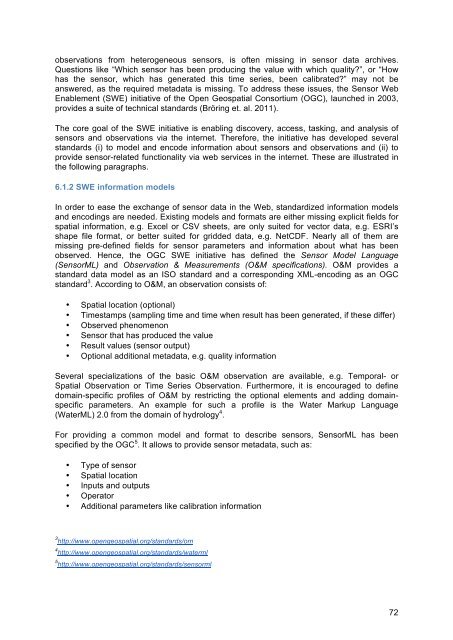Handbook of best practices
Handbook%20of%20best%20practices
Handbook%20of%20best%20practices
Create successful ePaper yourself
Turn your PDF publications into a flip-book with our unique Google optimized e-Paper software.
observations from heterogeneous sensors, is <strong>of</strong>ten missing in sensor data archives.<br />
Questions like “Which sensor has been producing the value with which quality?”, or “How<br />
has the sensor, which has generated this time series, been calibrated?” may not be<br />
answered, as the required metadata is missing. To address these issues, the Sensor Web<br />
Enablement (SWE) initiative <strong>of</strong> the Open Geospatial Consortium (OGC), launched in 2003,<br />
provides a suite <strong>of</strong> technical standards (Bröring et. al. 2011).<br />
The core goal <strong>of</strong> the SWE initiative is enabling discovery, access, tasking, and analysis <strong>of</strong><br />
sensors and observations via the internet. Therefore, the initiative has developed several<br />
standards (i) to model and encode information about sensors and observations and (ii) to<br />
provide sensor-related functionality via web services in the internet. These are illustrated in<br />
the following paragraphs.<br />
6.1.2 SWE information models<br />
In order to ease the exchange <strong>of</strong> sensor data in the Web, standardized information models<br />
and encodings are needed. Existing models and formats are either missing explicit fields for<br />
spatial information, e.g. Excel or CSV sheets, are only suited for vector data, e.g. ESRI’s<br />
shape file format, or better suited for gridded data, e.g. NetCDF. Nearly all <strong>of</strong> them are<br />
missing pre-defined fields for sensor parameters and information about what has been<br />
observed. Hence, the OGC SWE initiative has defined the Sensor Model Language<br />
(SensorML) and Observation & Measurements (O&M specifications). O&M provides a<br />
standard data model as an ISO standard and a corresponding XML-encoding as an OGC<br />
standard 3 . According to O&M, an observation consists <strong>of</strong>:<br />
• Spatial location (optional)<br />
• Timestamps (sampling time and time when result has been generated, if these differ)<br />
• Observed phenomenon<br />
• Sensor that has produced the value<br />
• Result values (sensor output)<br />
• Optional additional metadata, e.g. quality information<br />
Several specializations <strong>of</strong> the basic O&M observation are available, e.g. Temporal- or<br />
Spatial Observation or Time Series Observation. Furthermore, it is encouraged to define<br />
domain-specific pr<strong>of</strong>iles <strong>of</strong> O&M by restricting the optional elements and adding domainspecific<br />
parameters. An example for such a pr<strong>of</strong>ile is the Water Markup Language<br />
(WaterML) 2.0 from the domain <strong>of</strong> hydrology 4 .<br />
For providing a common model and format to describe sensors, SensorML has been<br />
specified by the OGC 5 . It allows to provide sensor metadata, such as:<br />
• Type <strong>of</strong> sensor<br />
• Spatial location<br />
• Inputs and outputs<br />
• Operator<br />
• Additional parameters like calibration information<br />
3 http://www.opengeospatial.org/standards/om<br />
4 http://www.opengeospatial.org/standards/waterml<br />
5 http://www.opengeospatial.org/standards/sensorml<br />
72


